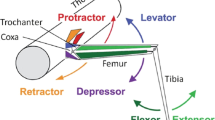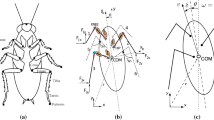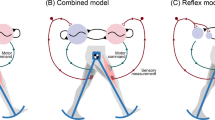Abstract
Classical engineering approaches to controlling a hexapod walker typically involve a central control instance that implements an abstract optimal gait pattern and relies on additional optimization criteria to generate reference signals for servocontrollers at all the joints. In contrast, the gait of the slow-walking stick insect apparently emerges from an extremely decentralized architecture with separate step pattern generators for each leg, a strong dependence on sensory feedback, and multiple, in part redundant, primarily local interactions among the step pattern generators. Thus, stepping and step coordination do not reflect an explicit specification based on a global optimization using a representation of the system and its environment; instead they emerge from a distributed system and from the complex interaction with the environment. A similarly decentralized control at the level of single leg joints also may explain the control of leg dynamics. Simulations show that negative feedback for control of body height and walking direction combined with positive feedback for generation of propulsion produce a simple, extremely decentralized system that can handle a wide variety of changes in the walking system and its environment. Thus, there is no need for a central controller implementing global optimization. Furthermore, physiological results indicate that the nervous system uses approximate algorithms to achieve the desired behavioral output rather than an explicit, exact solution of the problem. Simulations and implementation of these design principles are being used to test their utility for controlling six-legged walking machines.
Similar content being viewed by others
References
Arbib, M. (Ed.) 1995. The Handbook of Brain Theory and Neural Networks, Bradford Books/MIT Press: Cambridge, MA.
Bässler, U. 1983. Neural Basis of Elementary Behavior in Stick Insects, Springer-Verlag: Heidelberg.
Bässler, U. 1986. Afferent control of walking movements in the stick insect Cuniculina impigra. II. Reflex reversal and the release of the swing phase in the restrained foreleg. J. Comp. Physiol. A, 158:351-362.
Beer, R.D. and Gallagher, J.C. 1992. Evolving dynamical neural networks for adaptive behavior. Adaptive Behavior, 1:91-122.
Beer, R.D., Chiel, H.J., Quinn, R.D., Espenschied, K.S., and Larsson, P. 1992. A distributed neural network architecture for hexapod robot locomotion. Neural Computation, 4:356-365.
Berns, K., Piekenbrock, St., and Dillmann, R. 1994. Learning control of a six-legged walking machine. In Proceedings of the Fifth International Symposium on Robotics and Manufacturing, M. Jamashidi, Ch. Ngyuen, R. Lumia, and J. Yuh (Eds.), ASME Press: New York, Vol. 5, pp. 29-34.
Brown, T.G. 1911. The intrinsic factors in the act of progression in the mammal. Proc. R. Soc. London, Ser. B, 84:308-319.
Brunn, D.E. and Dean, J. 1994. Intersegmental and local interneurons in the metathorax of the stick insect Carausius morosus which monitor middle leg position. J. Neurophysiol., 72:1208-1219.
Büschges, A., Schmitz, J., and Bässler, U. 1995. Rhythmic patterns in the thoracic nerve cord of the stick insect induced by pilocarpine. J. Exp. Biol., 198:435-456.
Burrows, M. 1996. The Neurobiology of an Insect Brain, Oxford University Press: Oxford.
Chrachri, A. and Clarac, F. 1987. Induction of rhythmic activity in motoneurons of crayfish thoracic ganglia by cholinergic agonists. Neurosci. Letters, 77:49-54.
Churchland, P.S. and Sejnowski, T.J. 1988. Perspectives on cognitive neuroscience. Science, 242:741-745.
Cohen, A.H. and Boothe, D.L. 1999. Sensorimotor interactions during locomotion: Principles derived from biological systems. Autonomous Robots, 7:239-245.
Cruse, H. 1976a. The function of the legs in the free walking stick insect, Carausius morosus. J. Comp. Physiol., 112:235-262.
Cruse, H. 1976b. The control of body position in the stick insect (Carausius morosus) when walking over uneven surfaces. Biol. Cybern., 24:25-33.
Cruse, H. 1985a. Which parameters control the leg movement of a walking insect? II. The start of the swing phase. J. Exp. Biol., 116:357-362.
Cruse, H. 1985b. Coactivating influences between neighbouring legs in walking insects. J. Exp. Biol., 114:513-519.
Cruse, H. 1990. What mechanisms coordinate leg movement in walking arthropods? Trends in Neurosciences, 13:15-21.
Cruse, H. and Steinkuehler, U. 1993. Solution of the direct and inverse kinematic problems by a common algorithm based on the mean of multiple computations. Biol. Cybern., 69:345-351.
Cruse, H. and Bartling, C. 1995. Movement of joint angles in the legs of a walking insect, Carausius morosus. J. Insect Physiol., 41:761-771.
Cruse, H., Müller-Wilm, U., and Dean, J. 1993. Artificial neural nets for a 6-legged walking system. In From Animals to Animats 2, J.-A. Meyer, H.L. Roitblat, and S.W. Wilson (Eds.), MIT Press: Cambridge, MA, pp. 52-60.
Cruse, H., Kindermann, T., Schumm, M., Dean, J., and Schmitz, J. 1998a. Walknet—A biologically inspired network to control six-legged walking. Neural Networks, 11:1435-1447.
Cruse, H., Dean, J., Kindermann, T., Schmitz, J., and Schumm, M. 1998b. Simulation of complex movements using artificial neural networks. Z. Naturforschung, 53c:628-638.
Dean, J. 1989. Leg coordination in the stick insect, Carausius morosus: Effects of cutting thoracic connectives. J. Exp. Biol., 145:103-131.
Dean, J. 1990. Coding proprioceptive information to control movement to a target: Simulation with a simple neural network. Biol. Cybern., 63:115-120.
Dean, J. 1991a. Effect of load on leg movement and step coordination of the stick insect, Carausius morosus. J. Exp. Biol., 159:449-471.
Dean, J. 1991b. A model of leg coordination in the stick insect, Carausius morosus. II. Description of the kinematic model and simulation of normal step patterns. Biol. Cybern., 64:403-411.
Dean, J. 1992. A model of leg coordination in the stick insect, Carausius morosus. III. Responses to perturbations of normal coordination. Biol. Cybern., 66:335-343.
Dean, J. 1998. Animats and what they can tell us. Trends in Cognitive Sciences, 2:60-67.
Dean, J. and Wendler, G. 1982. Stick insects walking on a wheel: Perturbations induced by obstruction of leg protraction. J. Comp. Physiol., 148:195-207.
Dean, J. and Wendler, G. 1983. Stick insect locomotion on a walking wheel: Interleg coordination of leg position. J. Exp. Biol., 103:75-94.
Delcomyn, F. 1980. Neural basis of rhythmic behavior in animals. Science, 210:492-498.
Delcomyn, F. 1985. Factors regulating insect walking. Ann. Rev. Entomol., 30:239-256.
Delcomyn, F. 1999. Walking robots and the central and peripheral control of locomotion in insects. Autonomous Robots, 7:259-270.
Donner, M.D. 1987. Real-Time Control of Walking, Birkhäuser: Boston.
Espenshied, K.S., Quinn, R.D., Chiel, H.J., and Beer, R.D. 1993. Leg coordination mechanisms in stick insect applied to hexapod robot locomotion. Adaptive Behavior, 1:455-468.
Espenshied, K.S., Quinn, R.D., Chiel, H.J., and Beer, R.D. 1996. Biologically-based distributed control and local reflexes improve rough terrain locomotion in a hexapod robot. Robotics and Autonomous Systems, 18:59-64
Franceschini, N., Pichon, J.M., and Blanes, C. 1992. From insect vision to robot vision. Philos. Trans. R. Soc. London Series B, 337:283-294.
Friesen, W.O. 1989. Neuronal control of leech swimming movements. In Neuronal and Cellular Oscillators. Cellular Clocks Series, J.W. Jacklet (Ed.), Marcel Dekker Inc.: NY, Vol. 2, pp. 269-316.
Graham, D. and Cruse, H. 1981. Coordinated walking of stick insects on a mercury surface. J. Exp. Biol., 92:229-241.
Graham, D. 1977. Simulation of a model for the coordination of leg movement in free walking insects. Biol. Cybern., 26:187-198.
Graham, D. 1978. Unusual step pattern in the free walking grasshopper Neoconocephalus robustus. II. A critical test of the leg interactions underlying different models of hexapod co-ordination. J. Exp. Biol., 73:159-172.
Graham, D. 1979. Effects of circum-oesophageal lesion on the behaviour of the stick insect Carausius morosus. II. Changes in walking co-ordination. Biol. Cybern., 32:147-152.
Graham, D. 1985. Pattern and control of walking in insects. Adv. Insect Physiol., 18:31-140.
Grillner, S., Deliagina, T., Ekeberg, Oe., El Manira, A., Hill, R.H., Lansner, A., Orlovsky, G.N., and Wallen, P. 1995. Neural networks that co-ordinate locomotion and body orientation in lamprey. Trends in Neurosciences, 18:270-279.
Hallam, J. 1998. Why mix robotics and biology? IROS'98 Workshop WT1: Defining the future of biomorphic robotics, October 13, 1998, Victoria, B.C., Canada.
Heiligenberg, W.F. 1991. Neural Nets in Electric Fish, MIT Press: Cambridge, MA.
Jander, J.P. 1985. Mechanical stability in stick insects when walking straight and around curves. In Insect Locomotion, M. Gewecke and G. Wendler (Eds.), Parey: Berlin, pp. 33-42.
Kristan, W.B., Jr., Lockery, S.R., and Lewis, J.E. 1995. Using reflexive behaviors of the medicinal leech to study information processing. J. Neurobiology, 27:380-389.
Maes, P. 1993. Behavior-based artificial intelligence. In From Animals to Animats 2, J.A. Meyer, H.L. Roitblat, and S.W. Wilson (Eds.), MIT Press: Cambridge, MA, pp. 2-10.
Maes, P., Mataric, M.J., Meyer, J.-A., Pollack, J., and Wilson, S.W. (Eds.) 1996. From Animals to Animats 4, MIT Press: Cambridge, MA.
McGhee, R.B. and Sun, S.-S. 1974. On the problem of selecting a gait for a legged vehicle. In Proceedings of the 6th IFAC Symposium on Automatic Control in Space. IFAC: Pittsburgh and Moscow, pp. 53-62.
Müller-Wilm, U., Dean, J., Cruse, H., Weidemann, H.J., Eltze, J., and Pfeiffer, F. 1992. Kinematic model of a stick insect as an example of a 6-legged walking system. Adaptive Behavior, 1:155-169.
Pearson, K.G. 1972. Central programming and reflex control of walking in the cockroach. J. Exp. Biol., 56:173-193.
Pearson, K.G. and Franklin, R. 1984. Characteristics of leg movements and patterns of coordination in locusts walking on rough terrain. Int. J. Robotics Res., 3:101-112.
Pearson, K.G. and Iles, J.F. 1973. Nervous mechanisms underlying intersegmental coordination of leg movements during walking in the cockroach. J. Exp. Biol., 58:725-744.
Pfeiffer, F., Eltze, J., and Weidemann, H.-J. 1995. Six-legged technical walking machine considering biological principles. Robotics and Autonomous Systems, 14:223-232.
Rind, R.C. 1997. Collision avoidance: From the locust eye to a seeing machine. In From Living Eyes to Seeing Machines, M.V. Srinivasan and S. Venkatesh (Eds.), Oxford University Press: Oxford, pp. 105-125.
Rixe, A. and Dean, J. 1995. Mechanisms of curve walking in the stick insect Carausius morosus. In Proceedings of the 23th Göttingen Neurobiology Conference, N. Elsner and R. Menzel (Eds.), Stuttgart: Thieme Verlag, p. 217.
Ryckebusch, S. and Laurent, G. 1993. Rhythmic patterns evoked in locust leg motor neurons by the muscarinic agonist pilocarpine. J. Neurophysiol., 69:1583-1595.
Schmitz, J. and Haßfeld, G. 1989. The treading-on-tarsus reflex in stick insects: Phase-dependence and modifications of the motor output during walking. J. Exp. Biol., 143:373-388.
Schmitz, J., Dean, J., and Kittmann, R. 1991. Central projections of leg sense organs in the stick insect, Carausius morosus (Insecta, Phasmida). Zoomorphology, 111:19-33.
Schmitz, J., Ernst, S., and Reich, J. 1996. A new intersegmental coordinating influence in the walking system of the stick insect. In Brain and Evolution Proceedings of the 24th Goettingen Neurobiology Conference, N. Elsner and H.-U. Schnitzler (Eds.), Stuttgart: Thieme Verlag, p. 129.
Schmitz, J. and Ernst, S. Intra-and intersegmental load compensating reactions of walking stick insects, Carausius morosus, in preparation.
Schmitz, J., Bartling, C., Brunn, D.E., Cruse, H., Dean, J., Kindermann, T., Schumm, M., and Wagner, H. 1995. Adaptive properties of hard-wired neuronal systems. Adaptive Eigenschaften festverdrahteter neuronaler Systeme. Verh. Dtsch. Zool. Ges., 88.2:165-179.
Selverston, A. 1995. Modulation of circuits underlying rhythmic behaviors. J. Comp. Physiol. A, 176:139-147.
Srinivasan, M.V., Chah, J.S., Weber, K., Venkatesh, S., Nagle, M.G., and Zhang, S.W. 1999. Robot navigation inspired by principles of insect vision. Robotics and Autonomous Systems, 26:203-216.
Steinkühler, U. and Cruse, H. 1998. A holistic model for an internal representation to control the movement of a manipulator with redundant degrees of freedom. Biol. Cybernetics, 79:457-466.
Weidemann, H.-J., Eltze, J., and Pfeiffer, F. 1993. Leg design based on biological principles. In Proc. of the 1993 IEEE Conference on Robotics and Automation, pp. 352-358.
Wendler, G. 1964. Laufen und Stehen der Stabheuschrecke Carausius morosus: Sinnesborstenfelder in den Beingelenken als Glieder von Regelkreisen. Z. vergl. Physiol., 48:198-250.
Wilson, D.M. 1966. Insect walking. Ann. Rev. Entomol., 11:103-122.
Author information
Authors and Affiliations
Rights and permissions
About this article
Cite this article
Dean, J., Kindermann, T., Schmitz, J. et al. Control of Walking in the Stick Insect: From Behavior and Physiology to Modeling. Autonomous Robots 7, 271–288 (1999). https://doi.org/10.1023/A:1008980606521
Issue Date:
DOI: https://doi.org/10.1023/A:1008980606521




